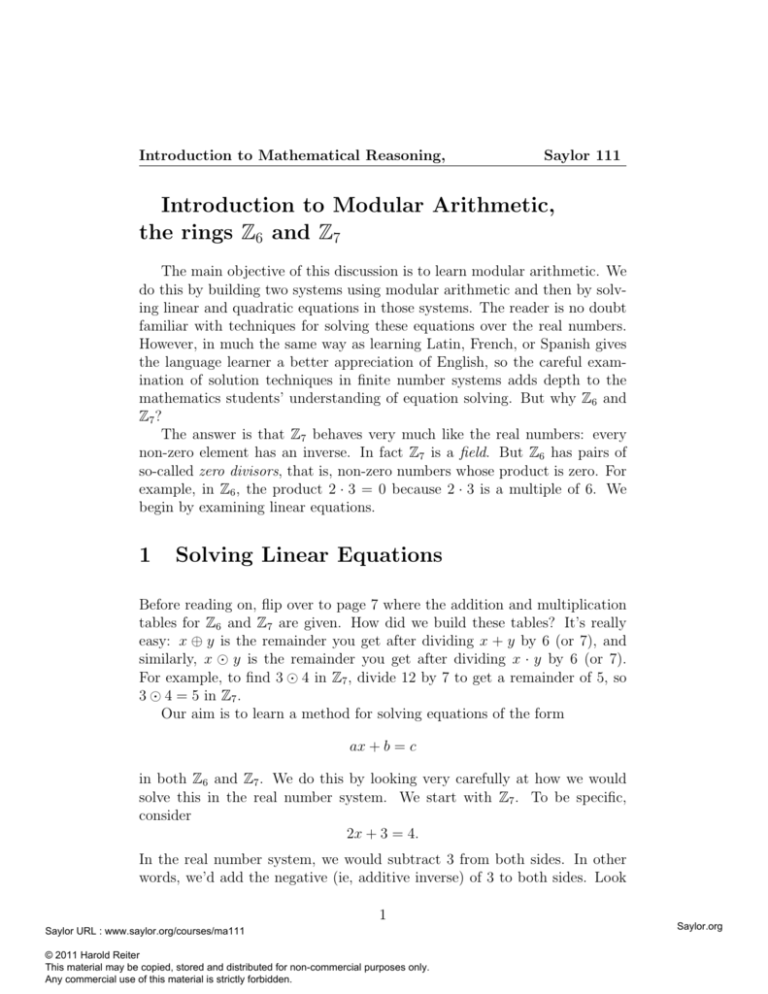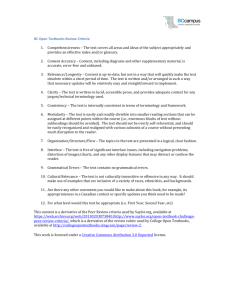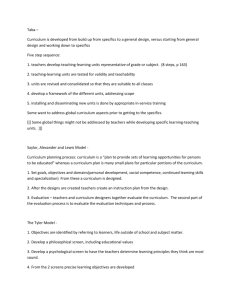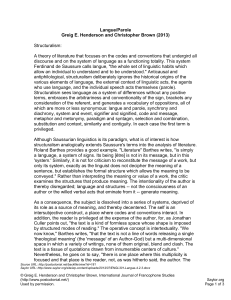Introduction to Modular Arithmetic, Building the Rings to Z? and Z?
advertisement

Introduction to Mathematical Reasoning,
Saylor 111
Introduction to Modular Arithmetic,
the rings Z6 and Z7
The main objective of this discussion is to learn modular arithmetic. We
do this by building two systems using modular arithmetic and then by solving linear and quadratic equations in those systems. The reader is no doubt
familiar with techniques for solving these equations over the real numbers.
However, in much the same way as learning Latin, French, or Spanish gives
the language learner a better appreciation of English, so the careful examination of solution techniques in finite number systems adds depth to the
mathematics students’ understanding of equation solving. But why Z6 and
Z7 ?
The answer is that Z7 behaves very much like the real numbers: every
non-zero element has an inverse. In fact Z7 is a field. But Z6 has pairs of
so-called zero divisors, that is, non-zero numbers whose product is zero. For
example, in Z6 , the product 2 · 3 = 0 because 2 · 3 is a multiple of 6. We
begin by examining linear equations.
1
Solving Linear Equations
Before reading on, flip over to page 7 where the addition and multiplication
tables for Z6 and Z7 are given. How did we build these tables? It’s really
easy: x ⊕ y is the remainder you get after dividing x + y by 6 (or 7), and
similarly, x ¯ y is the remainder you get after dividing x · y by 6 (or 7).
For example, to find 3 ¯ 4 in Z7 , divide 12 by 7 to get a remainder of 5, so
3 ¯ 4 = 5 in Z7 .
Our aim is to learn a method for solving equations of the form
ax + b = c
in both Z6 and Z7 . We do this by looking very carefully at how we would
solve this in the real number system. We start with Z7 . To be specific,
consider
2x + 3 = 4.
In the real number system, we would subtract 3 from both sides. In other
words, we’d add the negative (ie, additive inverse) of 3 to both sides. Look
1
Saylor URL : www.saylor.org/courses/ma111
© 2011 Harold Reiter
This material may be copied, stored and distributed for non-commercial purposes only.
Any commercial use of this material is strictly forbidden.
Saylor.org
Introduction to Mathematical Reasoning,
Saylor 111
at the addition table for Z7 to see that 4 is the negative of 3 (3 + 4 = 0,
right?). So we have (2x + 3) + 4 = 4 + 4 or (2x + 3) + 4 = 1. Now since
addition is associative, we have 2x + (3 + 4) = 1, but since 3 + 4 = 0, our
equation reduces to 2x + 0 = 1.
Since a + 0 = a for all a (0 is the additive identity), we can write 2x = 1.
Now what. In the real system we would multiply by the multiplicative inverse
of 2, sometimes written 21 . Look at the multiplication table of Z7 to find the
multiplicative inverse of 2. Recall that a number e in a mathematical system
is a multiplicative identity if e · x = x · e = x for all number x. So 1 is a
multiplicative identity for Z7 . The multiplicative inverse of a number u is
a number v such that uv = 1. So what is the multiplicative inverse of 2?
Check out the row of 2 in the table and notice that 2·4 = 1. So 4 is the
inverse of 2. Now multiply on the left by 4 to get
4 · 2x = 4 · 1.
Use the associativity of · to get (4 · 2) x = 4. That is 1 · x = 4. Finally,
1 · x = x, so we have our solution x = 4. Of course, since Z7 is finite we
could simply list the values of 2x + 3 as a function of x to see if and when
the value 4 pops up.
x 2x + 3
0
3
5
1
0
2
2
3
4
4
6
5
1
6
You can see from this that the range of the linear function f (x) = 2x + 3
is the entire set of Z7 . This is the case for the real number system when the
slope m of the line f (x) = mx + b is not zero.
Moving on to Z6 , we will try to solve
2x + 3 = 4
in the same way we did in Z7 .
First ‘subtract’ 3 (note that in Z6 , 3 = −3) from both sides:
(2x + 3) + 3 = 4 + 3
2
Saylor URL : www.saylor.org/courses/ma111
© 2011 Harold Reiter
This material may be copied, stored and distributed for non-commercial purposes only.
Any commercial use of this material is strictly forbidden.
Saylor.org
Introduction to Mathematical Reasoning,
Saylor 111
and use associativity to get
2x + 0 = 1
and finally
2x = 1.
Notice that 3 is its own additive inverse. Why?
Now look for the inverse of the number 2 (we use the word inverse here and
elsewhere to mean multiplicative inverse because we have the word negative
to use for the additive inverse of a number). In other words, look for a
number we can multiply by 2 to get the multiplicative identity 1. Whoops,
there isn’t one. The reason is that the row of 2 in the times table of Z6 does
not have a 1. So 2 has no inverse. The equation 2x = 1 has no solutions.
Since 2x = 1 is equivalent to our original equation, it follows that
2x + 3 = 4
has no solutions.
What is the range of f (x) = 2x + 3 in Z6 ? Look at the tables to see that
2x + 3 can be any of the number in the set {1, 3, 5}.
Now we turn to solving quadratic equations.
2
Solving Quadratic Equations
As we did for linear equations, we will look carefully at the solution techniques
we use in equations defined over real numbers to see the extent to which they
can be used in Z7 and Z6 . The general quadratic equation in one variable is
ax2 + bx + c = 0.
There are two common techniques, factoring and using the quadratic formula.
But we don’t even know if the quadratic formula holds in Z7 so we will have
to think deeply about why it is true in the system R.
Factoring
Consider x2 − 4x + 3 = 0. In R we write x2 − 4x + 3 = (x − 3) (x − 1)
without much thinking. Can we do this in Z7 ? Let’s see. Try to find the
3
Saylor URL : www.saylor.org/courses/ma111
© 2011 Harold Reiter
This material may be copied, stored and distributed for non-commercial purposes only.
Any commercial use of this material is strictly forbidden.
Saylor.org
Introduction to Mathematical Reasoning,
Saylor 111
reason for each step below:
(x − 3) (x − 1) =
=
=
=
=
=
(x − 3) x + (x − 3) (−1)
x2 − 3x + x (−1) + (−3) (−1)
x2 + 4x + 6x + 4 · 6(−1 = 6 in Z7 )
x2 − 3x + 6x + 3(−1 = 6 in Z7 )
x2 + 3x + 3
x2 − 4x + 3.
So it seems the factoring technique might work. Now given a factorable
quadratic, how do we solve the corresponding equation? Of course, you know
that we set each of the factors x − 3 and x − 1 equal to zero. We can do this
because R satisfies the zero product property.
That is to say, if the product of two numbers is zero, then one of the
two numbers must actually be zero. Put another way, the product of two
non-zero numbers is non-zero. Thus, x2 − 4x + 3 = 0 has two solutions in
Z7 , x = 3 and x = 1.
Completing the square in R
Often we resort to using the quadratic formula to solve quadratic equations when factoring isn’t possible. To understand why the quadratic formula works, we must think about how to derive it. Recall that we derived
the quadratic formula using a technique called completing the square. We
will use this on x2 − 4x + 3 = 0 in R to illustrate. First, note that
x2 − 4x + 4 = (x − 2)2 .
We can add 1 to both sides of x2 − 4x + 3 = 0 to get x2 − 4x + 4 = 1 and then
write (x − 2)2 = 1. Take the square root of both sides to get x − 2 = ±1 and
solve the two equations x − 2 = 1 and x − 2 = −1 to get x = 3 and x = 1.
Let us look carefully at the derivation of the quadratic formula in R.
c
c
b
Divide by the non-zero coefficient a to get x2 + x + = 0. Subtract and
a
a
a
2
b
c
b2
b
b
to both sides to get x2 + x + 2 = − + 2 .
then add the square of
2a
a
4a
a 4a
Since the left side is a perfect square, we can write
¶2
µ
c
b2
b
= − + 2.
x+
2a
a 4a
4
Saylor URL : www.saylor.org/courses/ma111
© 2011 Harold Reiter
This material may be copied, stored and distributed for non-commercial purposes only.
Any commercial use of this material is strictly forbidden.
Saylor.org
Introduction to Mathematical Reasoning,
This leads to
Saylor 111
r
c 4a
b2
b
=±
− ·
x+
2
2a
4a
a 4a
and finally
r
b2 − 4ac
b
x = − ±
2a √
4a2
−b ± b2 − 4ac
.
=
2a
The quadratic formula in Z7
Can we do this in Z7 ?
Start with ax2 + bx + c = 0, where a 6= 0. Since each non-zero number in
Z7 has an inverse, we can write
x2 + a−1 bx + a−1 c = 0
and
¡
¢
x2 + a−1 bx = − a−1 c
Can we add a number to x2 + a−1 bx to make it a perfect square as we did
above? The number we added above to the left side is (a−1 b/2)2 . So we get
for the left side x2 + a−1 bx + (a−1 b/2)2 . Try squaring x + a−1 b/2 and you’ll
see that it works. So now the right side is
¡
¢
− a c +
−1
µ
1 −1
a b
2
¶2
µ
¶
1 −1 1 −1
−a c + a b
a b
2
2
¡
¢
−a−1 c + 4a−1 b 4a−1 b
−a−1 c + 2a−1 a−1 bb
−a−1 caa−1 + 2a−1 a−1 bb
−a−1 a−1 ac + 2a−1 a−1 bb
¡ 2
¢
2b − ac a−2
¡
¢
4 · 2b2 − 4 · ac 4−1 a−2
¡ 2
¢
1b − 4ac (2a)−2 .
−1
=
=
=
=
=
=
=
=
5
Saylor URL : www.saylor.org/courses/ma111
© 2011 Harold Reiter
This material may be copied, stored and distributed for non-commercial purposes only.
Any commercial use of this material is strictly forbidden.
Saylor.org
Introduction to Mathematical Reasoning,
Saylor 111
Notice that we have made use of several interesting properties in Z7 ; for
example 2 · 4 = 1 and 4−1 = 2. What we have is a situation with which we
are quite familiar, namely that under some circumstances we can take the
square root (and get a number in our number system). Thus
¡
¢2 ¡
¢
(x + a−1 b/2)2 = x + 4a−1 b = b2 − 4ac (2a−1 )2
and
x + 4a−1 b = ±
£¡ 2
¢
¤1
b − 4ac (2a)−2 2 .
Therefore, distributing the square root across the product,
p
(b2 − 4ac)
−1
x = −4a b ±
2a
p
(b2 − 4ac)
= −(2−1 a−1 b) ±
2a
p
2
(b − 4ac)
−b
±
=
2a √ 2a
−b ± b2 − 4ac
=
2a
Ah ha! same formula.
Which of the quadratic equations x2 +x+1 = 0, x2 +x+2 = 0, x2 +x+3 =
0, x2 + x + 4 = 0, x2 + x + 5 = 0 and x2 + x + 6 = 0 have solutions in Z7 ?
Use the quadratic formula to solve them.The table below may help
x x2 + x
0
0
2
1
6
2
5
3
6
4
2
5
0
6
In order that x2 + x + k = 0 we must have x2 + x = 7 − k. For example,
x2 + x + 4 = 0 if x2 + x = 7 − 4 = 3, but 3 does not belong to the range of
x2 + x.
Thus, x2 + x + 1 = 0 has two solutions, x = 2, x = 4; x2 + x + 2 = 0 has
one solutions x = 3; x2 + x + 3 = 0 has no solution; x2 + x + 4 = 0 has no
6
Saylor URL : www.saylor.org/courses/ma111
© 2011 Harold Reiter
This material may be copied, stored and distributed for non-commercial purposes only.
Any commercial use of this material is strictly forbidden.
Saylor.org
Introduction to Mathematical Reasoning,
Saylor 111
solution; x2 + x + 5 = 0 has two solutions, x = 1, x = 5; and x2 + x + 6 = 0
has no solution.
Solving quadratic equations in Z6
Can we do all this in Z6 ? The answer here is no and the reason is similar
to what we saw in the case of linear equations.
Again, we ask what members of our system have square roots. Since
12 = 1, 22 = 4, 32 = 3, 42 = 4, 52 = 1, we see that 3 has a unique square root,
1 and 4 have two square roots and 2 and 5 do not have square roots.
Consider the quadratic 3x2 + c = 0 in Z6 . The list below has each of the
equations, where c ∈ Z6 and the solutions. For c = 1, 3x2 + 1 = 0 has no
solution. For c = 2, 3x2 + 2 = 0 has no solution. For c = 3, 3x2 + 3 = 0 has
three solutions x = 5, x = 3, x = 1. For c = 4, 3x2 + 4 = 0, has no solutions.
For c = 5, 3x2 + 5 also has no solutions. Finally for c = 0, 3x2 = 0 has three
solutions, x = 0, x = 2, and x = 4.
The main trouble here is that Z6 does not satisfy the Zero Product Property. To see this, look at the times table for Z6 . Find a pair of nonzero
numbers whose product is zero. There are two such pairs, {2, 3} and {3, 4}.
Now suppose we want to solve (x − 2)(x − 3) = 0. With the Zero Product
property, we would just say x − 2 = 0 so x = 2 and x − 3 = 0 so x = 3.
But notice that x = 5 also satisfies the equation: (5 − 2)(5 − 3) = 3 · 2 = 0.
Notice that also x = 0 satisfies the equation.
7
Saylor URL : www.saylor.org/courses/ma111
© 2011 Harold Reiter
This material may be copied, stored and distributed for non-commercial purposes only.
Any commercial use of this material is strictly forbidden.
Saylor.org
Introduction to Mathematical Reasoning,
Saylor 111
The digit tables for Z6 and Z7
Below you’ll find the addition and multiplication tables for Z6 and Z7 .
Notice that in the tables for Z7 we have dropped the cell notation even though
the objects are cells. Its that at this point there is no compelling reason to
emphasize that notation.
Addition and multiplication in Z6
[0]
[0]
[1]
[2]
[3]
[4]
[5]
⊕
[0]
[1]
[2]
[3]
[4]
[5]
[1]
[1]
[2]
[3]
[4]
[5]
[0]
[2]
[2]
[3]
[4]
[5]
[0]
[1]
[3]
[3]
[4]
[5]
[0]
[1]
[2]
[4]
[4]
[5]
[0]
[1]
[2]
[3]
[5]
[5]
[0]
[1]
[2]
[3]
[4]
¯
[0]
[1]
[2]
[3]
[4]
[5]
[0]
[0]
[0]
[0]
[0]
[0]
[0]
[1]
[0]
[1]
[2]
[3]
[4]
[5]
[2]
[0]
[2]
[4]
[0]
[2]
[4]
[3]
[0]
[3]
[0]
[3]
[0]
[3]
[4]
[0]
[4]
[2]
[0]
[4]
[2]
[5]
[0]
[5]
[4]
[3]
[2]
[1]
Addition and multiplication in Z7
⊕
0
1
2
3
4
5
6
0
0
1
2
3
4
5
6
1
1
2
3
4
5
6
0
2
2
3
4
5
6
0
1
3
3
4
5
6
0
1
2
4
4
5
6
0
1
2
3
5
5
6
0
1
2
3
4
6
6
0
1
2
3
4
5
¯
0
1
2
3
4
5
6
8
Saylor URL : www.saylor.org/courses/ma111
© 2011 Harold Reiter
This material may be copied, stored and distributed for non-commercial purposes only.
Any commercial use of this material is strictly forbidden.
0
0
0
0
0
0
0
0
1
0
1
2
3
4
5
6
2
0
2
4
6
1
3
5
3
0
3
6
2
5
1
4
4
0
4
1
5
2
6
3
5
0
5
3
1
6
4
2
6
0
6
5
4
3
2
1
Saylor.org
Introduction to Mathematical Reasoning,
Saylor 111
Problems.
1. Construct the addition and multiplication tables for the digits of Z11
in the space provided.
⊕
0
1
2
3
4
5
6
7
8
9
10
0
1
2
3
4
5
9
Saylor URL : www.saylor.org/courses/ma111
© 2011 Harold Reiter
This material may be copied, stored and distributed for non-commercial purposes only.
Any commercial use of this material is strictly forbidden.
6
7
8
9
10
Saylor.org
Introduction to Mathematical Reasoning,
¯
0
1
2
3
4
5
6
7
8
9
10
0
1
2
3
4
5
6
Saylor 111
7
8
9
10
2. Use the tables above to solve the equation 3x − 4 = 9 showing each
step and stating how you get from each step to the next one.
3. Use the grid below to sketch
origin has been labeled.
.
.
.
.
.
.
.
.
.
.
.
(0, 0)
the graph of y = 3x − 4. Notice that the
.
.
.
.
.
.
.
.
.
.
.
.
.
.
.
.
.
.
.
.
.
.
.
.
.
.
.
.
.
.
.
.
.
.
.
.
.
.
.
.
.
.
.
.
.
.
.
.
.
.
.
.
.
.
.
.
.
.
.
.
.
.
.
.
.
.
.
.
.
.
.
.
.
.
.
.
.
.
.
.
.
.
.
.
.
.
.
.
.
.
.
.
.
.
.
.
.
.
.
.
.
.
.
.
.
.
.
.
.
.
4. Which of the numbers in Z11 have square roots?
10
Saylor URL : www.saylor.org/courses/ma111
© 2011 Harold Reiter
This material may be copied, stored and distributed for non-commercial purposes only.
Any commercial use of this material is strictly forbidden.
Saylor.org
Introduction to Mathematical Reasoning,
Saylor 111
5. Which of the following quadratic equations are solvable over Z11 ? Find
solutions to all that are solvable. Show your reasoning.
(a) 2x2 − 3x + 4 = 0
(b) 3x2 − 4x + 2 = 0
(c) 4x2 + 2x − 3 = 0
11
Saylor URL : www.saylor.org/courses/ma111
© 2011 Harold Reiter
This material may be copied, stored and distributed for non-commercial purposes only.
Any commercial use of this material is strictly forbidden.
Saylor.org








